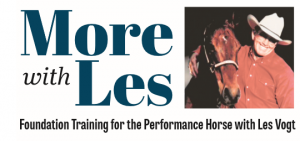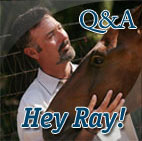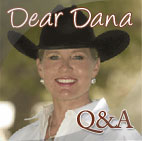The Elevator Bit
After looking at collection and rating speed the last couple of columns, Les takes a break to look at bits.
 The elevator bit might look a litt le odd, but it’s a tool I developed several years ago, and I really like what it can do for some horses. If a horse has learned to get away with things in a smooth snaffl e it makes riding them a lot of work. If this is your situation, and the horse is ready, that is, he’s picked up everything we’ve worked on so far, you might want to try the elevator bit.
The elevator bit might look a litt le odd, but it’s a tool I developed several years ago, and I really like what it can do for some horses. If a horse has learned to get away with things in a smooth snaffl e it makes riding them a lot of work. If this is your situation, and the horse is ready, that is, he’s picked up everything we’ve worked on so far, you might want to try the elevator bit.
Now here’s the way that an elevator bit works. Since the curb is so loose, the bit will stretch the horse’s mouth upon contact, just like a regular snaffle does, but at a certain point, he’s going to feel the chain too.
Handling the Chargey Horse
 Now that we have learned how to “rate” our speed, let’s take a look at handling too much forward motion.
Now that we have learned how to “rate” our speed, let’s take a look at handling too much forward motion.
Now I’m going to tell you how to deal with a horse that’s a bit chargey. That is, he has a lot more forward motion than you enjoy, and not as much control as you would like. It’s a common problem, but you’ve got to fix it.
I’ve learned how to deal with this kind of horse by working on their neck and by reverse psychology. If he wants to go faster and push me, that is, if he wants to choose speed, I don’t like that idea much. I’m paying for the feed here, and I should get to make those choices. But what do I do? I can’t whip him; he’s too big. So I’ll make him think I agree with him and let him go, but when he wants to slow down, I’m not going to let him. And all the time I’m going to keep his shoulders up, occasionally asking him to frame up, but I’m going to keep him going right along. When he wants to slow, sentence him to three laps more. He’ll be saying, “Hey buddy, I’m getting a little tired here.” He’ll look back at you (and that alone makes it worth it) and say, “Why don’t you slow me down?” And you say, “Why? I’m starting to like this!” You want to ride him until he’s thrilled with the idea of stopping. Don’t cripple him, mind you, but make him look forward to you deciding when it’s time to quit. Then ride to the middle of the arena, let him stop, get off, unsaddle and give him his reward.
Too Much Speed?
After showing us in last issue’s column the importance of having the neck, Les offers tips on rating your horse.
 Do you feel like you’re off to the races every time you ask for a lope? While many horses will stay relaxed right from the start, some, especially those who are a litt le scared, or horses that have been held back all their lives, will want to take off like bullets! A horse like this is no fun to ride and can become dangerous if he’s not controlled. Here are some tips and exercises to try if you want to rate your horse back a litt le at the lope. By “rating” we mean being able to control the speed.
Do you feel like you’re off to the races every time you ask for a lope? While many horses will stay relaxed right from the start, some, especially those who are a litt le scared, or horses that have been held back all their lives, will want to take off like bullets! A horse like this is no fun to ride and can become dangerous if he’s not controlled. Here are some tips and exercises to try if you want to rate your horse back a litt le at the lope. By “rating” we mean being able to control the speed.
Collection Problems
After discovering last issue how collection can promote lightness, Les shows us indicators of what might lead to problems.
 In my clinics I run into a lot of horses that are fairly advanced but often they have got a hole in them. And the common problem and the common fix are going to be the same and it’s the neck. Often times these horses have an attitude in certain places. Every now and then they decide to rebel, to defy you. And what area of the horse shows defiance first? The neck! If it stiffens up, it’s the first signal that you are about to go for a ride that you’re not asking for.
In my clinics I run into a lot of horses that are fairly advanced but often they have got a hole in them. And the common problem and the common fix are going to be the same and it’s the neck. Often times these horses have an attitude in certain places. Every now and then they decide to rebel, to defy you. And what area of the horse shows defiance first? The neck! If it stiffens up, it’s the first signal that you are about to go for a ride that you’re not asking for.
So, before you can have what you want in terms of performance, you have to have the neck. Defiance is caused by an attitude, and an attitude can happen with horses just like people. But it’s got to be like someone in the military, if you have an attitude you’d better keep it to yourself, and that’s the way I feel about a horse. They all have different mindsets, but if they have an “attitude,” let’s overcome it by insisting that we get respect from them.
Developing lightness in your horse
Last issue, Les pointed out the details of collection. Now we look a little deeper and get to work.
 Riding a collected horse is always a thrill. Instead of the lope feeling fl at and strung out, it will become almost a circular rhythm as you feel the energy go from the hindquarters all the way through the horse’s soft ly rounded spine and then roll back to the haunches again. It is a stride that is fl uid and powerful at the same time, no matt er what the speed is. Collection is also the physical state where your horse is most balanced and prepared to respond to whatever cue you give. This is because he is carrying most of his weight on his hindquarters, so that his front end is lighter and easier to maneuver.
Riding a collected horse is always a thrill. Instead of the lope feeling fl at and strung out, it will become almost a circular rhythm as you feel the energy go from the hindquarters all the way through the horse’s soft ly rounded spine and then roll back to the haunches again. It is a stride that is fl uid and powerful at the same time, no matt er what the speed is. Collection is also the physical state where your horse is most balanced and prepared to respond to whatever cue you give. This is because he is carrying most of his weight on his hindquarters, so that his front end is lighter and easier to maneuver.
Collection: You are the key to getting it right
 After reviewing the keys to maneuvers last issue, Les points out details of collection.
After reviewing the keys to maneuvers last issue, Les points out details of collection.
Without a soft neck and poll, collection is impossible, so if you still have any resistance in the neck during any of the exercises that we’ve done so far, go back and work on them. I ride a horse in a clinic that is stiff to start with, and after I work one side and then the other, he starts to lighten up. There are a lot of great concepts, but I want to point out that because it is a clinic situation, I’m throwing more at this horse than I would at home. If the horse had been developed with all the tools and guidelines that I’m giving you, he would never have been that dull to begin with.
Collection: The key to maneuvers
 Last issue, Les wrapped up Exercises 3 and 4. As we move into more athletic maneuvers, we examine a critical piece: collection.
Last issue, Les wrapped up Exercises 3 and 4. As we move into more athletic maneuvers, we examine a critical piece: collection.
Objectives
• To concentrate on driving your horse from the back with your legs, in order to create a soft, round frame
• To continue to integrate the concept of 50 percent hands/50 percent legs into your riding
• To learn how to handle a tough or belligerent horse
• To learn about the elevator bit and how it can help you in your training program
Using what we know: Exercises 3 and 4
 Here is a bullet-list of what we’ve covered in the last several issues with Les.
Here is a bullet-list of what we’ve covered in the last several issues with Les.
Exercise #3
The third zone is the ribs or midsection
• Keep your horse straight or with a slight curve towards the direction of his intended movement
• Keep your outside arm straight out at a 45° angle
• Make sure your inside leg is off the horse
• Use your outside leg in the center of the horse’s ribs until he responds; if you don’t get a response to steady pressure, try bumping
Straightness check: maintaining alignment
43rd in a series
 Now that we have an attentive horse after Les’s instructions last issue, let’s evaluate control.
Now that we have an attentive horse after Les’s instructions last issue, let’s evaluate control.
Start at a walk in a straight line. Make sure your hands are evenly spaced out in front of you and that your legs are relaxed. As you move along, I want you to concentrate on feeling what the horse is doing rather than watching for problems. If you feel the horse start to bow or lean in either direction, use your hands and legs to get him straight again. If it helps, fi x your eyes on something in the distance and make sure he stays moving straight toward it.
 After last issue’s lesson on backing up, Les takes a moment now to remind why we don’t make a big deal about losing your horse’s attention.
After last issue’s lesson on backing up, Les takes a moment now to remind why we don’t make a big deal about losing your horse’s attention.
Sometimes when you’re riding you’re going to lose your horse’s attention. I say don’t make a big deal out of it. Some might not see as well as others, or may be more spooky, especially as far as young horses go, when they go off to the Bahamas every now and then; leave it alone and it goes away. Be patient.



 Read Columns
Read Columns

